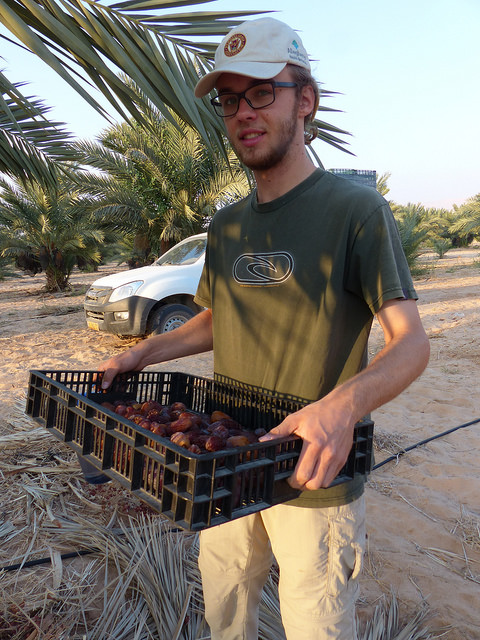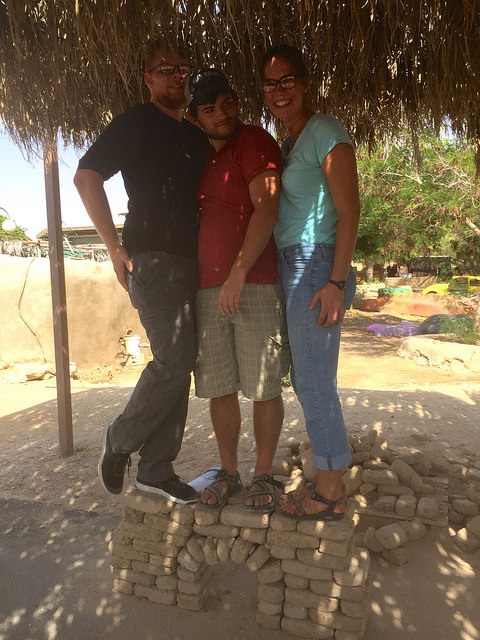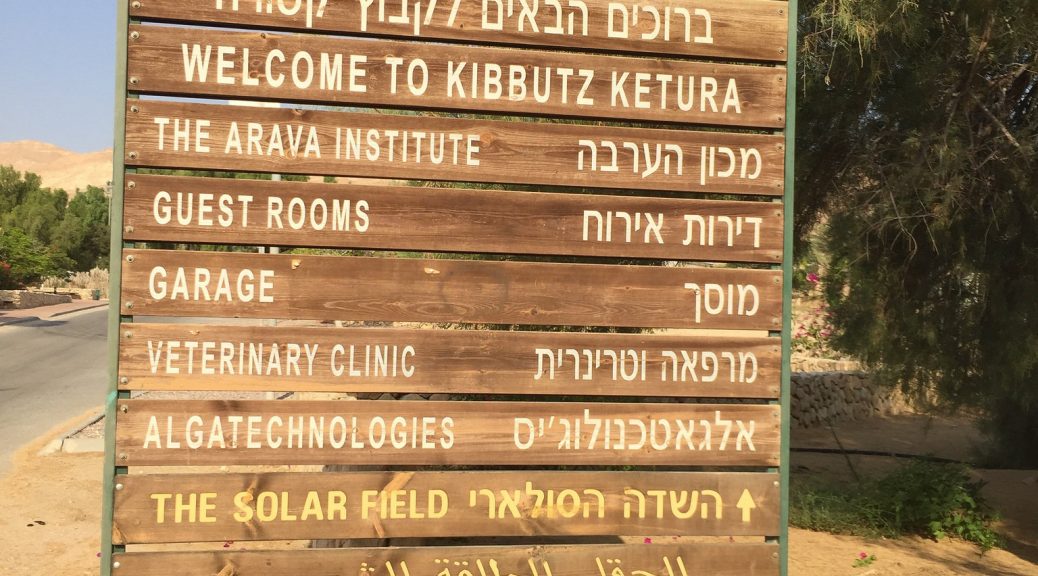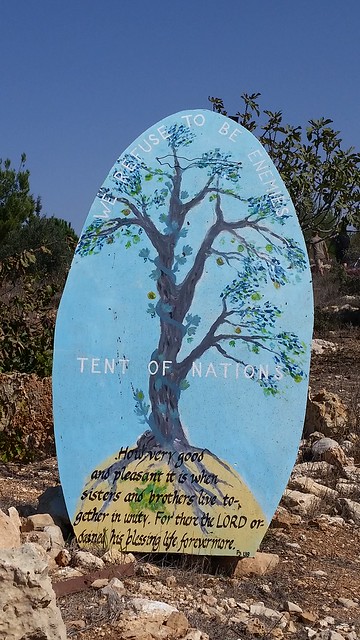(“warm” = 100°+ degrees)
Hu is He, He is She!
Hello from the Negev Desert! It’s hot. Last week it was 100 degrees at 8:00pm and they told us “a heat wave is coming”. It got up to 114° two days later… a bit much for a Kansas girl.
Bleary-eyed and exhausted from the first four days exploring Tel Aviv, Jaffa, Haifa, Akko, and Jericho, our group stumbled out of our bus onto Kibbutz K’tura on Wednesday, September 6th. We were greeted with fresh fruit AND cold water! Glory be! We had been going almost nonstop since the moment we put our feet on the ground in Tel Aviv, then five days ago (now 20+ days ago when I’m writing this).
This place, at first glance, appeared to be a place of rest and refuge, an actual oasis in a desert, a body of green and trees after a long drive through arid, sandy mountains and flatlands.
To answer your first question: what is a Kibbutz? Originally, a Kibbutz was set up as an intentionally socialist society. All of the income from the members of the Kibbutz (whether working on Kibbutz or off) goes into one pile o’ cash. No job is more important than the next (Head of Kibbutz  gets paid the same as the date picker). They eat in a common cafeteria, their kids go to the same school and originally slept away from their parents in “children’s houses” (sharing common caregivers so the parents could work more). Cars are shared between all members of the Kibbutz (20 cars for 200+ adults), etc., etc., etc. These Marxist influences made their way to the desert via European Jews making their “Aliyah” to Israel (fulfilling their birthright to return to the land that was promised to the Jews by God in the Bible).
gets paid the same as the date picker). They eat in a common cafeteria, their kids go to the same school and originally slept away from their parents in “children’s houses” (sharing common caregivers so the parents could work more). Cars are shared between all members of the Kibbutz (20 cars for 200+ adults), etc., etc., etc. These Marxist influences made their way to the desert via European Jews making their “Aliyah” to Israel (fulfilling their birthright to return to the land that was promised to the Jews by God in the Bible).
Jews emigrated to Israel from far and wide who were passionate, imaginative, incredibly dedicated to being Jewish, and, in my humble opinion, a tad bit crazy. They came with practically nothing and decided to settle in a desert. Just to give you an idea of the heat, it’s nearing the end of September and we’re lucky if the temperature doesn’t spike over 100° F every day. Luckily, they have a pool! There are many incredible stories about each individual Kibbutz and how it specifically was started, but we mainly heard the stories of three Kibbutzim: K’tura, Yahel, and Lotan.
First and foremost, K’tura. This lovely Kibbutz has been our home base and is the host of the Arava Institute for Environmental Studies, where we have been studying for the past two and a half weeks. We are all so incredibly grateful for their wonderful hospitality. Many groups only stay here for a couple of days, maybe a week. Some just stay for a meal and a tour of the off-grid village (more on that in Adrienne’s post).
A typical day here on the Kibbutz looked like this:
7:30 Wake up (our leaders and Levi tend to wake up an hour or so earlier)
8:30 Breakfast (yes, they get to breakfast before us as well)
9:30 Lecture #1
10:30 Lecture #2/Group check-in/Another kind of outing/extended lecture #1
12:30 Lunch
2:00 Lecture #3/Hebrew on some days
4:00 Break (a.k.a. nap/sleep/read/journal/frisbee/pool/play Avalon)
5:30/6 Dinner
7:30 Hebrew(?) or Evening off or lecture or meeting or other Shabbat/holiday programming
Let me tell you about Hebrew class. Hebrew class was a very, very unique experience. Our wonderful teacher, David, burst into the room on the first day, didn’t speak a word of English to us, started playing the beat of “We Will Rock You”, and jumped in front of my face and shouted “SHALOM! ANI DAVID!” (This really happened). I almost screamed. There were countless funny moments that can only be found in a language learning setting. One of my favorites was the time that David stood up while attempting to teach us pronouns and proclaimed, “hu is he, he is she!”. The comment was met by silence and then crazy laughter. And none of us will forget him climbing into the laundry shoot to pull out a blue t-shirt so he could explain the word for “blue”. We have learned so much from this crazy energy-filled man in the past two weeks. We will always remember him and his deep love for the Hebrew language.
Most of the lecture periods in our schedule were speakers connected to the Arava Institute. We also heard from members of the kibbutz in a community talk-back setting or a Kibbutz tour setting. We did not have a lecture that we didn’t enjoy and/or learn from. We spent our time learning primarily about our surroundings – the water crisis in the Middle East region, desert ecology, solar panels and alternative energy solutions, environmental leadership, kibbutz culture, “Nature knows no borders”, and talks discussing the intersection of peacebuilding and environmentalism, Reports and stories of ongoing projects in the surrounding area, the list goes on and on. Two of my favorite sessions (although, it is incredibly hard to choose a favorite) revolved around Kibbutz culture.
The first of my two favorites was a talk-back opportunity with three members of the Kibbutz – one of the founders who has been here since 1973, a child of Kibbutz members who is considering becoming a member, and a wonderfully sarcastic woman who told us what was wrong with the Kibbutz. Our group split up into three mini-groups and spent about 15 minutes with each person, asking questions about life on the Kibbutz and about their own personal stories. We learned about the process of entering into a Kibbutz community. It’s not as easy as you might think. First there are interviews, psychological tests, and more interviews. Then, there are invitations to stay for a weekend, then a week, maybe a month. A yes vote lets you come for a one or two year absorption period, and another yes after that means a one-year decision process. And then you’re pretty much in . . . for life if you want (they have a cemetery behind the Kibbutz where those who are here their entire life are buried). Kibbutz K’tura is a very open and pluralistic Kibbutz. Some Kibbutzim are stricter on the level of “Jewishness” expected of their participants.
My second favorite opportunity interacting with Kibbutz life was a mock Asepha session. Asepha is the main decision-making meeting, where everyone is invited to participate. That’s 150+ members here if all attend. We were given real cases with difficult subject matter that were first presented to committees on K’tura and a couple of the 11 neighboring Kibbutzim to read over and discuss. We had an environmental group, an education group, and type of head council group. Our group had to review the case, present it to the wider committee, open the floor for questions, and present our solution (followed by more discussion). This activity was perfect for our group. We have turned out to be quite the lively group – questions are our favorite. We had fun slipping into our roles and finding an argument to a solution just for the sake of arguing. However, later on we were told that we portrayed a very mild meeting, what was known as a “boring asepha”. The “fun” meetings are when people yell back and forth for hours on end, argue constantly for their point . . . only to laugh and hug after the meeting and accept the group decision. I personally loved this activity because it helped burst some of the apparent perfection of this Kibbutz. I found myself thinking, “oh, so they do have real, human problems on this Kibbutz” that may sound silly to some of you, but seriously if I didn’t have something to remind me that the people on this kibbutz weren’t in a constant state of happy, I would have exploded long ago.
We visited Kibbutz Yahel our first night at Kibbutz K’tura. There was a wedding at K’tura with over 900 people attending and we needed to be elsewhere. We arrived at Yahel and had a short tour and lecture. Compared to K’tura, Yahel is more politically conservative and has actually strayed away from some of the characteristic community living principles. For example, each family makes their own income and only part of it goes into the big pile o’ cash. And jobs have a variable wage scale on the kibbutz. They’re smaller than Kibbutz K’tura and have less of an emphasis on environmental sustainability. After our introductory tour and first speaker (and a brief moment when I thought that I was going to pass out from hunger), we made our way to the dining hall for a meal. Unfortunately, my stomach was not doing too hot and started viciously gurgling. Giving up on food, I stood up and walked around the outside of the dining hall, in need of air and generally curious. I didn’t see anything blindingly amazing, but I instead thought about general Kibbutz culture. It was a familiar concept to me – intentional community. Right? I couldn’t quite place why I felt so uneasy. We went back to our lecture space and heard about how the kibbutz hires foreign workers to farm date orchards, dairy farms, and other big agricultural projects in the various Kibbutzim. Many of us had difficult questions as we compared this situation to migrant and guest workers in the US.
Kibbutz Lotan was a different experience entirely. We arrived better adjusted to the intense heat of the desert. Lotan’s Center for Creative Ecology teaches and explores permaculture techniques. Walking around we saw structures made out of all kinds of recycled materials. We toured their organic gardens, saw compostable toilets, and marveled at their mud houses. We made mud bricks, built arches that we could stand on, ate lunch, did some more touring of their gardens, heard about work that they’ve done locally with this mud brick material that’s so perfect for the desert climate, and hung out in their solar-powered tea house. At this point, we felt more comfortable pestering our speakers with questions so pester  we did. I loved this visit and was comically thrilled when I was able to stand on top of the arch that our group built. Our guide thought we were hilarious when we turned practically everything we did into a competition (Lindsay and I obviously had THE best mud brick mixture). All in all, the day was hot but wonderful.
we did. I loved this visit and was comically thrilled when I was able to stand on top of the arch that our group built. Our guide thought we were hilarious when we turned practically everything we did into a competition (Lindsay and I obviously had THE best mud brick mixture). All in all, the day was hot but wonderful.
We have had so many wonderful opportunities while staying here. We’ve been snorkeling in the Red Sea (our leaders and Levi went twice). We hiked and explored Timna Park (where King Solomon’s mines were located), and spent a magical evening in the middle of the desert playing in the sand dunes and sitting in quiet reflection. One particularly amazing morning, most of us woke up very early and walked up a mountain behind the Kibbutz. Humming “Sedona” by the band Handmouth under our breaths we sat on the sandy rocks and watched the most amazing sunrise over the Edom mountains of Jordan. We’ve had the opportunity here to grow closer as a group, spending evenings together playing Avalon, talking, watching the stars, going for walks, and singing the Hebrew alphabet song.
Sometimes walking around from activity to activity we as a group rant and rave about the Kibbutz, their incredible hospitality, and the amazing lectures we’re having. Other times our conversations concern how there has to be a hidden side to Kibbutz life that we are not seeing. The culture is still new, and sometimes I have to wonder about some of their policies. They live in a desert, but their houses are surrounded by grass. Kids run around without a care in the world and if they are out late parents don’t worry because they know they are somewhere on the Kibbutz and thus safe. This starkly contrasts with the short but incredibly wild few days we had before coming here and, as we prepare for our time in Bethlehem, I can’t help but wonder how much our perspective of our time here on the Kibbutz will change.
-Lydia Chappell Deckert
Towels – A poem by Anna Ressler
We appreciate the gesture
but we’re drowning in clean towels
Really,
we would still feel welcome
if we used the same towel twice
(and didn’t I make my bed yesterday?!)
We say as much
but instant hospitality renders our request invalid
We appreciate the gesture
but the towels are invasive in my closet
the generosity is overwhelming
Isn’t two weeks enough to wear out our welcome?
(And weren’t we promised that the cookies were a one-time deal?)
It’s not that we’re complaining
We appreciate the gesture
but there are mounds of neatly folded towels
on bed
table
and floor
constant reminders of our burdensome position
of honored guest:
The uncomfortable imbalance of giving little
and receiving the world
in towels
The Black – A poem by Larissa Graber
I will never under-acknowledge the first sip of Turkish coffee—
the soulless black curdling my lip,
the squish of steamed grounds in between my teeth
—the third sip gathers a revolution that revolts the black into my brain.
The black persuades me,
“I have awoken. I will conquer.”
Turkish proverb (related by Uncle Bill)
Coffee should be hot as hell, black as death, sweet as love
This blog is brought to you by the blogging team: Larissa Graber, Lindsay Acker, Lydia Chappell Deckert, and Alice Maldonado
With generous support, occasional lattes, and probably too much editing from: “Uncle” Bill Goldberg and “Mama” Lisa Schirch
Guest-star writers for this issue include Andy King and Anna Ressler

